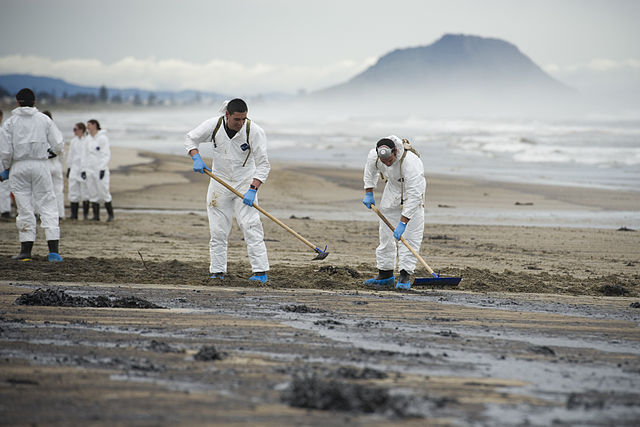[av_heading heading=’An Environmental Shift in the Southwest’ tag=’h2′ style=’blockquote modern-quote’ size=” subheading_active=’subheading_below’ subheading_size=’15’ padding=’10’ color=” custom_font=”]
Written by: Matthew McGuire | Photo by: NZ Defence Force assistance to OP Rena / Flickr
[/av_heading]
The Santa Barbara coastline has been transformed recently after an oil pipeline in production by Plains All American ruptured Tuesday afternoon. The closest city that has been effected the most is Goleta, California.
Currently, California is using %60 of the energy for natural gas. This is a clear problem for the residents of the state. It is progressive, but with the amount of the sunshine and wind within the state, the time is now to act on building support for reform in energy regulation in California, and across the globe. We should not only learn from others mistakes, but learn from our own, and create change so that these issues does not continue to happen, over and over again.
I recently spoke with Josh Fox, director of Gasland, about the risks and problems with offshore drilling, as well as storing oil and gas. His perspective helps build a better understanding of getting involved to prevent these environmental problems from reoccurring in the future.
Reuters, NPR and Democracy Now! have produced coverage with details behind the recent oil spill off the coast of California.
[av_video src=’https://youtu.be/al48iz2Pl5A’ format=’16-9′ width=’16’ height=’9′]
[av_video src=’https://youtu.be/zKB-gpYgUGI’ format=’16-9′ width=’16’ height=’9′]
In an article written in 2008, Steven Mufson goes over a very similar scenario to what happened near Santa Barbara in 1969. The greater connection is how a hopeful Obama used the angel of backing off offshore drilling, and reversed his view in 2010. This idea of politicians not keeping their word is a common trend, but like offshore drilling, also needs to stop.
[av_icon_box position=’left’ boxed=” icon=’ue81f’ font=’entypo-fontello’ title=’Steven Mufson: Washington Post Staff Writer (2008)’ link=” linktarget=” linkelement=” font_color=” custom_title=” custom_content=” color=” custom_bg=” custom_font=” custom_border=”]
On Jan. 28, 1969, a blowout on a Unocal rig six miles off the coast of California spilled 3 million gallons of oil into the waters off Santa Barbara. The blackened beaches and oil-soaked birds and seals became icons for the environmental movement and eventually brought oil exploration off the Atlantic and Pacific coasts of the United States to a halt.
Now, President Bush, Republicans in Congress and big oil companies want to reopen those waters to oil and gas exploration. In his radio address Saturday, Bush said that “technological advances have allowed us to explore oil offshore in ways that protect the environment” and that outer continental shelf areas now off limits “could produce enough oil to match America’s current production for almost 10 years.”
The issue has become a dividing line for the presidential candidates. Sen. John McCain (R-Ariz.) reversed his position last month and endorsed expanded offshore drilling, while Sen. Barack Obama (D-Ill.) wants to maintain the moratorium on offshore drilling, which he says would do nothing to immediately lower gasoline prices. In the past week, congressional Republicans have issued a blizzard of statements pushing for action before summer recess, and some Democrats may be leaning their way.
[/av_icon_box]
CNN reported the recent updates on the cleanup. Their report shows the damage and current glance at the restoration project.
[av_icon_box position=’left’ boxed=” icon=’ue81f’ font=’entypo-fontello’ title=’CNN – Progression in the Pacific’ link=” linktarget=” linkelement=” font_color=” custom_title=” custom_content=” color=” custom_bg=” custom_font=” custom_border=”]
Progress so far
As the cleanup entered its fourth day on Friday, vessels were “actually doing pretty well” recovering oil from the ocean, but “the harder part” will be cleaning the land — the shoreline, the beaches, the cliffs and the hillside near U.S. Highway 101 where the pipe ruptured, said U.S. Coast Guard Capt. Jennifer Williams.
“It could take months,” she said.
Officials provided a tally Friday of the cleanup and environmental damage:
• 10,000 gallons of oily water removed from the ocean;
• 91 cubic yards of oily solids and 800 cubic yards of oily soil removed from beaches;
• 9.5 square miles of ocean and 8.7 miles of coastline affected, from Arroyo Hondo beach to Refugio State Beach, near Goleta.
• Three brown pelicans were killed. Six more brown pelicans, two California sea lions and an elephant seal are being rehabilitated after oil coated them. A common dolphin was found dead without oil on its exterior, but it will be examined for signs of ingested oil.
[/av_icon_box]
Clean Energy
[av_magazine link=’category,1′ items=’5′ offset=’0′ tabs=’aviaTBtabs’ thumbnails=’aviaTBthumbnails’ heading=” heading_link=’manually,http://’ heading_color=’theme-color’ heading_custom_color=’#ffffff’ first_big=’aviaTBfirst_big’ first_big_pos=’top’]




